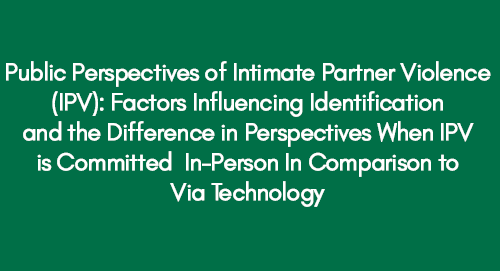
Public Perspectives of Intimate Partner Violence (IPV): Factors Influencing Identification and the Difference in Perspectives When IPV is Committed In-Person In Comparison to Via Technology
July 10, 2022
Business Management
July 10, 2022In the tapestry of global tourism, destination branding emerges as the brushstroke that delicately paints the narrative of significance, particularly poignant in the sombre canvas of dark tourism, where it becomes the guiding light in transforming places like Auschwitz Concentration Camp into powerful realms of historical understanding and remembrance.
Outline
- Introduction
- Concept of Destination Branding
- Dark Tourism Sector
- Significance of Destination Branding and Dark Tourism Sector
- Conclusion
- References
In the dynamic realm of global tourism, where destinations compete for attention, the importance of destination branding becomes increasingly profound. Beyond the mere attraction of visitors, it entails the artful construction of a narrative that encapsulates the very soul of a place. Nowhere is this significance more evident than in dark tourism, where the echoes of historical tragedies draw inquisitive minds yearning for comprehension and remembrance. In this exploration, we unravel the nuanced relationship between destination branding and the evolution of the dark tourism sector, delving into how destinations craft their identities.
A poignant case study unfolds against this backdrop, focusing on the Auschwitz Concentration Camp. As we navigate this exploration, we aim to dissect the multifaceted elements at play, examining how destination branding attracts and shapes the narratives surrounding these solemn sites. With its profound historical weight, Auschwitz is a compelling illustration of how effective branding can transform a site from a mere location into a poignant repository of human history and remembrance.
Introduction
Branding is undeniably one of the most crucial tools employed by organizations, institutions, and authorities. Its significance lies in its ability to leave a lasting impression on users while also providing them with a clear understanding of what to expect from the entity in question. Branding sets organizations apart from their competitors and elucidates why one choice might be superior to another (Baumeister et al., 2015). As competition intensifies across diverse industries, entities are increasingly driven to discover a unique niche. Sustaining relevance in any sector necessitates adopting strategies and techniques that distinguish them from their peers (Devasagayam et al., 2010).
Numerous strategies are deployed to boost the appeal of historical sites associated with post-World War II tragedies, often called dark tourism. These sites attract many visitors seeking insight into the sombre events that transpired in these locations. Countries invest in enhancing the aesthetics of these sites to promote dark tourism, as it has witnessed substantial growth with an increasing number of individuals willing to spend on experiences and knowledge related to these events. Additionally, promoting dark tourism often bolsters overall tourism, thus contributing to increased revenue and economic growth (Dark Tourism, 2020).
In the case of Auschwitz, attracting visitors to the campsite necessitates effectively communicating its unique aspects. While numerous destinations pique the interest of tourists, these sites must establish a distinctive feature that captivates maximum attention. Companies worldwide have employed various strategies and tactics to achieve this goal, with branding emerging as a critical and impactful approach to meeting their objectives (Bastos and Levy, 2012, p.350). Recognizing the significance of branding reveals that its scope extends beyond individual products and services; it can be applied to destinations, countries, and more, enabling them to create lasting impressions in the minds of their audiences (Hampf & Lindberg-Repo, 2011).
Concept of Destination Branding
Destination branding, an integral part of destination marketing, is a strategic endeavour to promote a tourist destination by establishing an associated brand. Like how branding is employed for products and services to create a unique identity, destination branding seeks to differentiate one location from another based on its distinct characteristics (Campelo et al., 2014). Establishing an identity for a destination is imperative in attracting tourists and shaping their perceptions. In a world filled with numerous travel options, a destination must be able to allure a substantial number of visitors to thrive (Merrilees et al., 2013). Destination branding is not only a catalyst for increased tourist traffic but also pivotal for economic growth and sustainability in terms of finances and popularity. In this context, we explore the role of destination branding in promoting dark tourism destinations, which are gaining increasing attention and recognition (Minić, 2012).
Tourism destinations have become centres of attraction, and significant efforts are channelled into enhancing the overall tourist experience and promoting these destinations globally. Modern tourists are motivated by diverse factors, and this trend has added value to the development of tourism destinations. Consequently, national authorities and local tourism management must devise specific strategies for unique tourism sites. Dark tourism promotes commercial destinations, and local governments adopt effective branding practices to enrich dark locations and sites. The complexity of the tourism development process is heightened by the need to address personal tourism factors, making it more challenging for local authorities (Birna, Hyde, and Farmaki, 2013).
A successful destination brand not only communicates ambition but also raises expectations and commits to delivering high-quality experiences consistently. Managing the development, planning, branding, operations, and marketing of the destination and its individual attractions, infrastructure, and services is crucial (Qu et al., 2011, p.470). Through destination branding, visitors must be assured that their entire experience will justify the effort and expenditure. The success of branding relies on its ability to resonate with and attract a large audience (Munar, 2011). Strongly branded destinations open up new opportunities in the dark tourism market, aiming to capture the minds of individuals worldwide and drive increased tourism. Over the past decade, dark tourism has seen a positive impact, with Poland adopting various branding strategies for concentration camp destinations (Powell, Kennell, and Barton, 2018).
While sharing some characteristics with product branding, destination branding has distinct objectives. It serves as a means for countries to showcase unique attributes that attract individuals to their regions. Notable examples of this are slogans such as 'Malaysia-Truly Asia,' 'Viva Las Vegas,' 'Kerala-God's Own Country,' and many more (Tasci, 2011, p.120). Destination branding performs various functions, including:
- Brands as perceptual entities
- Brands as communicators
- Brands as relationships
- Brands as value enhancers
Among these functions, brand as a relationship stands out as particularly significant. In this aspect, a destination brand is designed to possess a personality that allows it to establish meaningful connections with people (Morgan et al., 2011). Destination branding also fosters relationships between countries and their governments, positively impacting government relationships due to increased tourism. Additionally, dark tourism influences the products used in tourism and elevates the global ranking of tourist destinations. The concept of a tourism brand pertains to the global promotion of a destination's image, while local authorities concentrate on making tourist destinations more appealing to the public. Tourism destinations play a vital role in tourism development, especially in dark tourist destinations, and branding efforts in Poland are influencing the global perception of these destinations (Kumbirai et al., 2013). People base their vacation plans on destination promotions, and the visual representation of these locations plays a significant role in enticing a broad audience.
Dark Tourism Sector
Tourism is a fundamental government revenue source, providing a significant economic boost. In their quest to capitalize on the economic benefits of tourism, governments actively develop and promote various destinations to attract visitors. Tourism's contribution to economic growth is substantial, motivating governments to invest in branding efforts that distinguish their destinations and make them unique (Stone, 2013, p.310). While government initiatives focus on certain aspects and areas of a country for tourism development, private organizations also play a role. Some tourist spots may require entrance fees, while others are freely accessible (Hartmann, 2014, p.170).
Dark tourism, in contrast, involves travelling to places steeped in tragedy and death. Dark tourists have a distinct perspective, seeking to explore destinations with associated historical incidents. Although the number of individuals inclined toward dark tourism may be fewer than other forms, attracting them effectively to these sites is essential. Many dark tourists have exploratory intentions, whether for personal or professional purposes. In this context, it is crucial to communicate to these individuals how a particular destination offers a unique and different experience compared to other sites. Enhancing destination branding is of utmost importance in increasing the appeal of such areas (Biran & Hyde, 2013, p.191).
Examining dark tourism in Auschwitz reveals a site with a profound historical significance that serves as a major attraction. The site has transformed into a global tourist destination, drawing people from around the world who are keen to learn about its historical background. In 1947, Auschwitz was converted into a museum that preserves the relics of the post-camp era (Pilecki & Probosz, 2012). This museum now serves as an educational space for comprehending history and uncovering the past's harrowing realities. The loss of over 1.1 million lives in this camp stands as a sombre chapter in history, making it crucial for visitors to confront these dark events. Understanding post-war Europe is incomplete without a deep exploration of Auschwitz's history and the enduring impact it has had on humanity (Piotrowska et al., 2014).
Dark tourism, also known as black tourism, involves visiting sites related to battlefields, death, museums, and prison camps. It is closely linked to culture and heritage, with history playing a pivotal role in this form of tourism. Visitors to these sites are motivated by a thirst for knowledge about the past and the stories connected to these locations (Biran & Poria, 2012). There has been a notable increase in the number of individuals interested in understanding the experiences, tragedies, and struggles of people in the past. This growing interest has expanded the potential of tourism for many countries (White & Frew, 2013).
Auschwitz Concentration Camp
In 1940, the Auschwitz concentration camp was established, marking its grim status as the largest Nazi death and concentration camp. Situated in southern Poland, it initially served as a detention centre for political prisoners following World War II. However, Auschwitz soon transformed into a nightmarish killing centre that played a central role in the German effort to exterminate European Jews (Rajkowska et al., 2014, p.800). Over time, the detention centre evolved into a network of camps where primarily Jewish individuals, as well as anyone deemed an enemy of the Nazi regime, faced extermination. These prisoners endured unimaginable fates, ranging from forced labour and medical experimentation to brutal torture and death.
The prisoners at Auschwitz faced myriad perils, succumbing to the brutal consequences of overwork, disease, malnutrition, and inhumane living conditions (Kozirog et al., 2014). Their lives were marked by immense suffering and torment, creating a harrowing chapter in human history. Today, the Auschwitz concentration camp, which stands as the largest mass murder site in human history, is open to visitors. It serves as a poignant reminder, allowing them to gain insights into the profound struggles, pain, torture, and misery endured by the prisoners who were held within its walls.
Implications and Ethics in Branding Dark Tourism
By its very nature, dark tourism is distinct from conventional tourism destinations, and the authorities responsible for promoting such sites must uphold a strong sense of ethical responsibility. Promoting dark tourism sites has raised numerous concerns, as it has occasionally become intertwined with the leisure economy. Given that dark tourism is rooted in historical tragedies and sombre memories associated with places, it should not be driven primarily by profit motives (Biran and Hyde, 2013). Unfortunately, recent times have witnessed the commercialization of certain dark tourism locations, eroding these sites' intrinsic value and significance. When promoting dark tourism, authorities must not manipulate history to make it more appealing or captivating to visitors. The history and information associated with these places must remain accurate and unaltered to preserve their historical integrity and factual basis (Korstanje, 2015).
Furthermore, the advent of social media and the internet has exacerbated ethical concerns related to these sites. Individuals posting pictures or writing reviews about their experiences at dark tourism sites can sometimes blur the ethical boundaries associated with these locations. To mitigate these ethical challenges and enhance the overall ethical standing of dark tourism, international bodies such as UNESCO and others should collaborate closely with local governments. Together, they can establish standards and guidelines that all visitors to these sites must adhere to (Stone and Sharpley, 2013). Through vigilant oversight and collective efforts of these organizations, the likelihood of ethical breaches can be significantly reduced, ensuring the proper preservation of dark tourism sites. Additionally, educating visitors about appropriate behaviour and conduct at these sites can positively contribute to maintaining ethical standards in tourism. With increased awareness and knowledge about the significance of these places, visitors may become more inclined to uphold ethical practices (Korstanje and George, 2015).
Significance of Destination Branding and Dark Tourism Sector
The concept of destination branding has evolved significantly over the years, and its approach has adapted to the changing landscape. Since tourism plays a crucial role in a country's economy, it's imperative to understand how destination branding can be optimized for the nation's benefit (Schaar, 2013). New methods and strategies have emerged in the contemporary environment, enhancing destination branding and expanding communication channels to reach a broader target audience. Technological advancements have played a pivotal role in reaching a larger audience in less time, making it a key factor in the evolution of destination branding (Chen & Phou, 2013).
If employed by Auschwitz, effective destination branding could attract many visitors, significantly contributing to the local economy. Destination branding is about creating and establishing value for tourists, utilizing various approaches and techniques to achieve the desired objectives (Jetter & Chen, 2013, p.175). Communication strategies are essential and can be adopted by Auschwitz to engage with the target audience and boost tourism.
The country can enhance its economic well-being by focusing strongly on tourists and promoting the region as a tourist destination. Increased tourism will lead to more capital inflow, benefiting society. Furthermore, by promoting Auschwitz and its historical significance, the area can gain greater recognition and awareness among tourists. Although the dark tourism sector has experienced growth in recent years, there is still immense potential for further expansion. Tourists engaged in dark tourism seek authentic places that enhance their learning and overall experience, and hosts must effectively communicate the distinctive attributes of their destination (Raine, 2013). To achieve this, branding can be employed to elevate the perceived value of a place in the minds of potential visitors. It's essential to convey how one destination differs and why visitors should choose a specific area for their educational and experiential journey.
This research primarily emphasises the significance of destination branding in developing the dark tourism sector. While the tourism sector has been extensively researched, there is relatively limited research on the dark tourism sector and its connection to destination branding. This research aims to delve into the dynamics of dark tourism and explore how branding can be leveraged to enhance the associated outcomes.
Conclusion
In summary, the dynamic interplay between destination branding and the nuanced realm of dark tourism, exemplified by poignant sites such as Auschwitz, underscores a delicate equilibrium between economic motivations and ethical obligations. Destination branding, serving as a compelling tool for attracting visitors, not only drives tourism but also carries the responsibility of upholding the integrity of historical narratives. The ethical imperative takes centre stage as we navigate potential pitfalls like commercialization and historical distortion. Looking forward, untapped opportunities lie in innovative approaches to engage a global audience, fostering a deeper comprehension of historical tragedies. The convergence of destination branding and dark tourism prompts reflection on the intricate balance required to navigate between economic interests and the solemn duty of preserving and communicating historical truths, shaping a narrative that encourages meaningful exploration, enlightenment, and respectful remembrance within the evolving landscape of global tourism.
References
Altinay, L and Paraskevas, A (2008). Planning Research in Hospitality and Tourism, Butterworth Heinemann, London.
Bastos, W., & Levy, S. J. (2012). A history of the concept of branding: practice and theory. Journal of Historical Research in Marketing, 4(3), 350
Baumeister, C., Scherer, A. and Wangenheim, F.V. (2015). Branding access offers the importance of product brands, ownership status, and spillover effects to parent brands. Journal of the Academy of Marketing Science, 43(5).
Biran, A. and Hyde, K.F., 2013. New perspectives on dark tourism. International Journal of Culture, Tourism and Hospitality Research, 7(3), pp.191-198.
Biran, A., & Hyde, K. F. (2013). New perspectives on dark tourism. International Journal of Culture, Tourism and Hospitality Research, 7(3), 191
Biran, A., & Poria, Y. (2012). Reconceptualising dark tourism. Contemporary tourist experience: Concepts and consequences, 60.
Campelo, A., Aitken, R., Thyne, M. and Gnoth, J. (2014). Sense of place: The importance of destination branding. Journal of Travel Research, 53(2), pp.154-166.
Chen, C. F., & Phou, S. (2013). A closer look at destination: Image, personality, relationship and loyalty. Tourism management, 36, 269-278.
Devasagayam, P. R., Buff, C. L., Aurand, T. W., & Judson, K. M. (2010). Building brand community membership within organisations: a viable internal branding alternative? Journal of Product and Brand Management, 19(3).
Hampf, A., & Lindberg-Repo, K. (2011). Branding: The past, present, and future: A study of the evolution and future of branding.
Hartmann, R. (2014). Dark tourism, thanatourism, and dissonance in heritage tourism management: New directions in contemporary tourism research. Journal of Heritage Tourism, 9(2), 170
Jetter, L. G., & Chen, R. J. (2011). Destination branding and images: Perceptions and practices from tourism industry professionals. International Journal of Hospitality & Tourism Administration, 12(2), 175
Korstanje, M., 2015. The anthropology of dark tourism. Exploring the contradictions of capitalism. CERS, Leeds.
Korstanje, M.E. and George, B., 2015. Dark Tourism: Revisiting Some Philosophical Issues. E-review of Tourism Research, 12.
Koziróg, A., Otlewska, A., Piotrowska, M., Rajkowska, K., Nowicka-Krawczyk, P., Hachułka, M., ... & Żakowska, Z. (2014). Colonising organisms as a biodegradation factor affecting historical wood materials at the former concentration camp of Auschwitz II–Birkenau. International Biodeterioration & Biodegradation, 86.
Merrilees, B., Miller, D., & Herington, C. (2013). City branding: A facilitating framework for stressed satellite cities. Journal of Business Research, 66(1), 37-44.
Morgan, N., Pritchard, A., & Pride, R. (2011). Destination brands: Managing place reputation. Routledge.
Munar, M. A. (2011). Tourist-created content: rethinking destination branding. International journal of culture, tourism and hospitality research, 5(3).
Pilecki, W., & Probosz, M. (2012). The Auschwitz volunteer: beyond bravery. Aquila Polonica.
Piotrowska, M., Otlewska, A., Rajkowska, K., Koziróg, A., Hachułka, M., Nowicka-Krawczyk, P., ... & Żydzik-Białek, A. (2014). Abiotic determinants of the historical building's biodeterioration in the former Auschwitz II–Birkenau concentration and extermination camp. Plos One, 9(10), e109402.
Qu, H., Kim, L. H., & Im, H. H. (2011). A model of destination branding: Integrating the concepts of the branding and destination image. Tourism Management, 32(3), 470
Raine, R. (2013). A dark tourist spectrum. International Journal of Culture, tourism and hospitality Research, 7(3), 242-256.
Rajkowska, K., Otlewska, A., Koziróg, A., Piotrowska, M., Nowicka-Krawczyk, P., Hachułka, M., ... & Żydzik-Białek, A. (2014). Assessment of biological colonization of historic buildings in the former Auschwitz II-Birkenau concentration camp. Annals of Microbiology, 64(2), 800
Schaar, R. (2013). Destination branding: a snapshot. UW-L Journal of Undergraduate Research, 16(1), 5
Stone, P. (2013). Dark tourism scholarship: A critical review. International Journal of Culture, Tourism and Hospitality Research, 7(3), 310
Stone, P. R. (2012). Dark tourism and significant other death: Towards a model of mortality mediation. Annals of tourism research, 39(3), 1565
Stone, P.R. and Sharpley, R., 2013. Deviance, dark tourism and ‘dark leisure’: Towards a (re) configuration of morality and the taboo in secular society. In Contemporary Perspectives in Leisure (pp. 76-86). Routledge.
Tasci, A. D. (2011). Destination branding and positioning. Destination marketing and management: Theories and applications, 120
White, L., & Frew, E. (2013). Dark tourism and place identity: Managing and interpreting dark places. Routledge.
Minić, N., 2012. Development of „dark “tourism in the contemporary society. Зборник радова Географског института" Јован Цвијић" САНУ, 62(3), pp.81-103.
Powell, R., Kennell, J. and Barton, C., 2018. Dark Cities: A dark tourism index for Europe’s tourism cities, based on the analysis of DMO websites. International Journal of Tourism Cities.
Pereira, R.L., Correia, A.L. and Schutz, R.L., 2012. Destination branding: A critical overview. Journal of Quality Assurance in Hospitality & Tourism, 13(2), pp.81-102.
Kumbirai, M., Beaven, U., Charity, M., Patricia, M. and Forbes, K., 2013. Appropriateness of Branding as a Tourism Resuscitation Tool for Zimbabwe. American Journal of Tourism Management, 2(2), pp.47-54.
Young, B. and Hren, D., 2017. Introduction to qualitative research methods. MiRoR (Methods in Research on Research).
Birna, A., Hyde, K.F. and Farmaki, A., 2013. Dark tourism revisited: a supply/demand conceptualization. International Journal of Culture, tourism and hospitality Research.
Get 3+ Free Dissertation Topics within 24 hours?





























